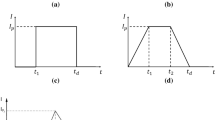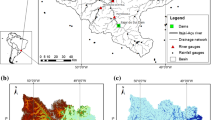Abstract
This paper presents a methodology for reservoir routing in general and for arid region in particular. The proposed methodology combines the mass conservation equation of the dam reservoir, the discharge equation of the dam outlet devices, and a dimensionless depth–volume equation to calculate the outflow hydrograph downstream of the dam for a given inflow hydrograph. The proposed model is solved numerically using first- and second-order Euler finite difference schemes and shows pretty good agreement when compared with analytical solution of a specific example in the published literature and with the traditional (modified puls) method (RMSE is 0.668, 0.673, and 0.94 m3/s respectively for the time step of 300 s). The results show that there is no significant difference between first- and second-order schemes which have been supported by published literature even with higher order methods. The results also show that the RMSE decreases with decreasing the value of the time step. The key parameter of the proposed model is the so-called reservoir coefficient, N, which is estimated from fitting depth–volume data with the dimensionless depth–volume equation. Best estimation of the reservoir coefficient provides reliable reservoir routing outflow hydrograph. The implementation of the methodology and the parameters selection has been illustrated on a real case study (AL-Ulb dam in Riyadh). The effect of reservoir condition wether it is full or empty is considered. The estimated reservoir coefficient N is 0.381, and the corresponding relative RMSE is 0.073. The estimated RMSE of the outflow hydrograph is 12.75 and 12.90 m3/s in case the reservoir is full and empty respectively when considering modified puls method as a reference case. The attenuation ratio on average is 65% in case the reservoir is full. However, in case of empty reservoir, an attenuation of 50% is reached for return periods more than 10 years. These results suggest that the design of reservoir in arid region should consider an empty reservoir routing, which leads to an economic design of the downstream flood channel. While in perennial rivers, a full reservoir routing is recommended. For further application of the proposed methodology, a priori analysis of eight proposed dam locations in different provinces in the Kingdom of Saudi Arabia is performed. The values of the reservoir coefficient N range between 0.39 and 0.68. The smallest value of the reservoir coefficient (N = 0.39) corresponds to the highest value of the reservoir shape factor (M = 3.06) which indicates reservoir of type II (Hill), while the rest of the reservoirs are of type III (Flood Plain Foothill). The values can be used as a prior design of these dams, and a detailed analysis using the proposed methodology is needed in the final stage.













Similar content being viewed by others
References
Borland WM, Miller CR (1958) Distribution of sediment in large reservoirs. J Hydraul Div 84(2):1587.1–1587.10
Chow VT, Maidment DR, Mays LW (1988) Applied hydrology, international editions. McGraw-Hill, New York, pp 242–251
Elfeki AM, Kamis AS, Al-Amri S, Bahrawi JA (2014) On The hydraulic design of dam’ outlets in arid zones. Life Sci J 7(11):254–260
Fenton JD (1992) Reservoir routing. Hydrol Sci 37(3):233–246
Fiorentinti M, Orlandini S (2013) Robust numerical solution of the reservoir routing equation. Adv Water Resour 59:123–132
Fread DL, Hsu KS (1993) Applicability of two simplified flood routing methods: level-pool and Muskingum–Cunge. In: Shen HW, Su ST, Wen F (eds) ASCE, National Hydraulic Engineering Conference. ASCE, San Francisco, pp 1564–1568
Hager WH, Sinniger R (1985) Flood storage in reservoirs. J Irrig Drain, ASCE 111(1):76–85
HEC-HMS (2015) Hydrologic modeling system. US Army Corps of Engineers, Hydrologic Engineering Center, Version 4.1
Horn RD (1987) Graphical estimation of peak flow reduction in reservoir. J Hydr Eng ASCE 113(11):1441–1450
Jha AK, Bloch R, Lamond J (2012) Cities and flooding: a guide to integrated urban flood risk management for the 21st century. The World bank, ISBN (paper): 978-0-8213-8866-2, pp 63
Li X, Wang BD, Shi R (2009) Numerical solution to reservoir flood routing. J Hydrol Eng 14(2):197–202. https://doi.org/10.1061/(ASCE)1084-0699(2009)14:2(197)
Michalec B (2015) Evaluation of an empirical reservoir shape function to define sediment distribution in small reservoirs. Water 7:4409–4426
Mohammadzadah-Habili J, Heidarpour M, Mousavi S, Haghiabi A (2009) Derivation of reservoir’s area-capacity equations. J Hydrol Eng 14(9):1017–1023
Rahmanian MR, Banihashemi MA (2012) Introduction of a new empirical reservoir shape function to define sediment distribution pattern in dam reservoirs. Trans Civil Eng 36(C1):79–92
Wheater HS (1996) Proceeding of the workshops on “Wadi hydrology and groundwater protection. In: Lineke JM, Saleh AMA, Sherif MM (eds) IHP-V, technical documents in hydrology, No. 1, UNESCO, Cairo, pp 2
Wheater HS (2002) Hydrology of wadi systems. IHP-V, technical documents in hydrology. In: Wheater H, Al-Weshah RA (eds) No. 55, UNESCO, Paris, pp 8
Williams JR, Hann RWJ (1972) HYMO: problem oriented computer language for building hydrologic models. Water Resour Res 8(1):79–86
Yevdjevich VM (1959) Analytical integration of the differential equation for water storage. J Res Natl Bur Stand B Math Math Phys 63B(1):43–52
Acknowledgements
This project was funded by the Deanship of Scientific Research (DSR), King Abdulaziz University, Jeddah, under grant no. (G-123-155-38). The authors, therefore, acknowledge with thanks DSR for technical and financial support.
Author information
Authors and Affiliations
Corresponding author
Rights and permissions
About this article
Cite this article
Kamis, A.S., Bahrawi, J.A. & Elfeki, A.M. Reservoir routing in ephemeral streams in arid regions. Arab J Geosci 11, 106 (2018). https://doi.org/10.1007/s12517-018-3440-7
Received:
Accepted:
Published:
DOI: https://doi.org/10.1007/s12517-018-3440-7




